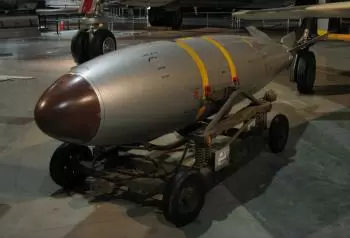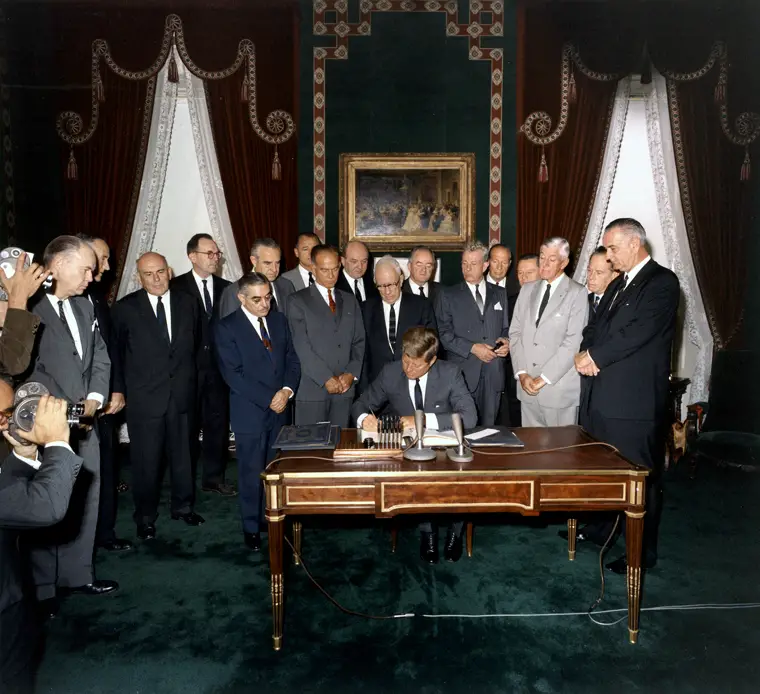
A weapon is an instrument used to attack or defend oneself. Within the different types of weapons there are nuclear weapons. A nuclear weapon is considered to be a weapon that uses nuclear energy.
If they distinguish two types of nuclear weapons depending on the function of nuclear energy:
-
Those that use nuclear energy directly to generate a large explosion, such as the atomic bomb.
-
Those that use nuclear energy as a source of energy for propulsion. For example nuclear submarines, aircraft carriers, etc.
Nuclear weapons are considered the most dangerous weapon designed so far in the world. Only a single bomb can destroy entire cities and leave a large amount of radioactivity in the area for decades. This radioactivity would be devastating for the environment and future generations.
At the moment nuclear weapons have only been used twice in war (US). They were the nuclear bombs dropped on Hiroshima and Nagasaki in August 1945 during World War II.
What countries have nuclear weapons?
So far it is known that the nuclear weapon countries are:
-
The United States
-
Russia
-
Great Britain
-
France
-
China
-
India
-
Pakistan
-
North Korea.
Furthermore, Israel is believed to have developed nuclear weapons that it itself has not recognized.
Many other countries are believed to have the capacity to manufacture nuclear weapons. Some of them are suspected of having some nuclear weapons development program.
States that had nuclear weapons in the past
The fall of the Soviet Union left several former Soviet republics in physical possession of nuclear weapons, though not operational control. They are:
-
Belarus.
-
Kazakhstan.
-
Ukraine.
South Africa produced six nuclear weapons in the 1980s, but dismantled them in the early 1990s.
What are the types of nuclear weapons?
There are two basic types of nuclear weapons: those that only use nuclear fission reactions and those that use fission and fusion reactions.
-
Fission weapons that obtain part of their explosive energy from nuclear fission reactions. They are usually called atomic bombs.
-
Fusion weapons that are generally known as thermonuclear weapons or as hydrogen bombs (H-bombs). Fusion reactions are carried out using hydrogen isotopes.
What are nuclear warheads?
A nuclear warhead is a technical term for the part of a missile that carries a nuclear weapon. Ballistic missiles are divided into two basic parts: a carrier and a loaded warhead. The warhead is manufactured separately and is independent of the rocket carrier. Oftentimes, it can be mounted on various types of carriers.
In 1986 there were 70,300 active weapons. In 2019 there are approximately 3,750 active nuclear warheads and 13,890 total nuclear warheads in the world.
Treaties related to nuclear weapons
Since the end of the Second World War and the subsequent cold war between the US and the Soviet Union, several multilateral treaties have been created. The purpose of these treaties is to prevent the proliferation of nuclear arms and nuclear tests, while promoting nuclear disarmament.
The main motivation is the devastating effects that a possible nuclear war would have on the planet.
These treaties include:
-
Treaty for the partial banning of nuclear tests.
-
Treaty on the Non-Proliferation of Nuclear Weapons.
-
Comprehensive Nuclear Test Ban Treaty (CTBT)
Some bilateral and plurilateral treaties and agreements seek to reduce or eliminate certain categories of the nuclear arsenal. We also want to avoid the proliferation of them and their vector systems.
Partial Nuclear Test Ban Treaty
The Treaty for the partial prohibition of nuclear tests was signed on August 5, 1963 in Moscow, shortly after the crisis in Cuba (beginning of detente).
 This treaty is a set of rules on the prohibition of nuclear weapons tests in the atmosphere and under water. The underground tests are not included in this prohibition.
This treaty is a set of rules on the prohibition of nuclear weapons tests in the atmosphere and under water. The underground tests are not included in this prohibition.
Nuclear Non-Proliferation Treaty
The treaty on the non-proliferation of nuclear weapons is an international treaty. It aims to reduce the use of nuclear weapons in the world and the risks that it entails.
It was drawn up and signed in 1968 and entered into force on March 5, 1970, when 43 countries ratified it. Currently 189 states are party to the treaty. The entity in charge of ensuring that it is applied is the International Atomic Energy Agency (IAEA).
The nuclear non-proliferation treaty is based on three fundamental pillars:
-
The non-proliferation of nuclear weapons and nuclear explosives.
-
Nuclear disarmament
-
The peaceful use of nuclear power.
This treaty considers two different categories of State: those that are allowed to develop, trade and possess nuclear weapons and those that are not.
Only five nuclear-weapon states (NWS) with nuclear capabilities belong to the first group:
-
The United States.
-
The United Kingdom.
-
The Soviet Union (currently Russia)
-
France.
-
China.
These countries are also the only permanent members of the United Nations Security Council.
Comprehensive Nuclear Test Ban Treaty
The Comprehensive Nuclear Test Ban Treaty is an international treaty, signed for the first time on September 10, 1996. This treaty prohibits the conduct of nuclear tests in and by the signatory countries.
What is the Federation of American Scientists?
The Federation of American Scientists (FAS) is an organization founded in 1945. It is composed by scientists from the Manhattan Project. The members believed people involved had an ethical obligation to bring their knowledge and experience to support those who had to make crucial decisions. The people involved would be that scientists, engineers and other types of innovators linked to nuclear technology.
Early FAS projects focused on nuclear weapons control and research into nuclear energy for peaceful uses. The FAS currently deals with a large number of issues where the contribution of science and technology based analysis is crucial.
The "Strategic Security Program" carries out projects that can reduce potential threats consisting of a number of biological, chemical, conventional and nuclear weapons.
The US faces a wide range of potential security threats that have changed enormously since the end of the Cold War.